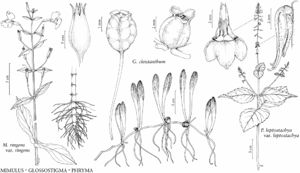Difference between revisions of "Mimulus ringens var. ringens"
FNA>Volume Importer |
FNA>Volume Importer |
(No difference)
| |
Revision as of 18:28, 24 September 2019
Leaves: blade 50–150 mm, internodes 30–70 mm. Fruiting pedicels 20–45(–60) mm. Calyces 10–16(–20) mm, lobes 2–6 mm.
Phenology: Flowering Jun–Sep.
Habitat: Fens, seepage slopes, wet meadows, marshy shores, swamp borders, wet woods.
Elevation: 0–500(–1000) m.
Distribution
Alta., Man., N.B., N.S., Ont., P.E.I., Que., Sask., Ala., Ark., Calif., Colo., Conn., Del., D.C., Ga., Idaho, Ill., Ind., Iowa, Kans., Ky., La., Maine, Md., Mass., Mich., Minn., Miss., Mo., Mont., Nebr., N.H., N.J., N.Y., N.C., N.Dak., Ohio, Okla., Oreg., Pa., R.I., S.C., S.Dak., Tenn., Vt., Va., Wash., W.Va., Wis., introduced in w Europe (England).
Discussion
Variety ringens in Alberta, California, Colorado, Idaho, Montana, Oregon, and Washington occurs in very scattered, often apparently natural habitats; with more or less certainty, these plants probably are introduced. The basis for all accounts from Colorado apparently is a single specimen collected near Denver in 1895 (Bethel s.n., COLO); there is no indication in recent literature that Mimulus ringens has persisted there. It has been included in the Texas flora based on a listing by S. L. Hatch et al. (1990); the basis for that is obscure, and M. ringens has not been otherwise reported or documented from Texas.
Selected References
None.
